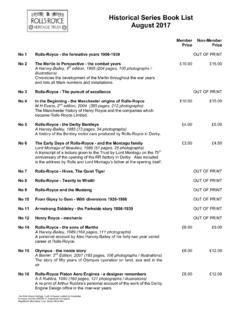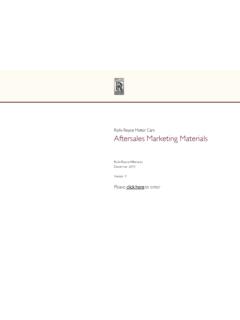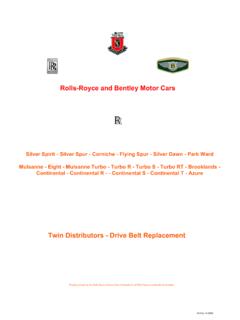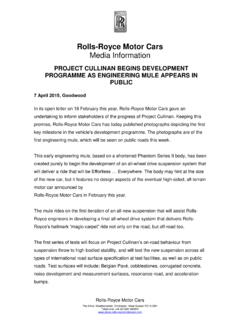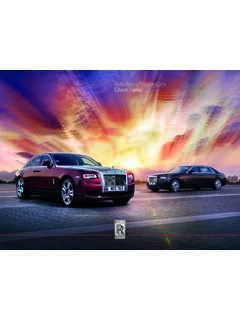Transcription of Rolls - Royce Chassis Division in Belper 1940 - 1950 Page ...
1 Rolls - Royce Chassis Division in Belper 1940 - 1950 Page 1 of 14 INTRODUCTIONThis article was written in response to a request from Audrey Barrass, Secretary of the Belper Historical Society and a distant cousin of mine, to place on record my recollections of the activities of Rolls - Royce in Belper , following the outbreak of the Second World War, and in particular the role that Clan Foundry played between 1940 and is a personal recollection of the time that I spent as an engineering apprentice in Belper and Derby during the war, and my involvement in the war-time activities of Clan Foundry as a Research and Experimental Department of Rolls - Royce during the led to the evolution of the post-war motor Car Division in Belper .
2 Before the Design and Detail Drawing Office moved to Crewe in 1950 to become integrated with the production activities in the Crewe also includes my own personal activities within the motor Car Division , until my retirement from Rolls - Royce motor cars (Crewe) in November 1985. Reginald J. Spencer MBEJ anuary 2005R-R EVACUATION TO BELPERWhen the Second World War was declared in September 1939, most of the engineering and clerical staff were moved from Derby, leaving only the main manufacturing facility at Nightingale Road, and several satellite workshops were scattered around the Derbyshire countryside to duplicate essential work, to prevent the disruption of and District was chosen as the evacuation area to accommodate the various essential services.
3 And several properties were requisitioned to accommodate a young lad who walked daily from 94, Belper Lane (this house was initially built by Strutts in 1803 as the Parish Workhouse) to the Herbert Strutt School, between 1935 and 1939, I was intrigued to see the bare Chassis of a Rolls - Royce car being driven along the A6 towards the Peak District where much of the road testing took place. The sight of the intrepid test drivers, wearing flat caps and goggles, fuelled my imagination and established a burning ambition to join this famous company.
4 This was to be my dream for the wrote to the company in Nightingale Road and was subsequently invited to attend for an interview with Mr , the Apprentice Supervisor. I was requested to join the Mailing Department on the 8th March 1940, until the start of the intake for engineering apprentices in September of the same Mailing Dept. was located in the Lodge of Field Head House in Chesterfield Road, the old Courthouse, at the top of the jitty leading from Field Lane to Chesterfield Road. The Mailing Office Manager was Mr GPO delivered to, and collected mail from, the Lodge, and after sorting, it was taken out by the Mail lads to the various Aero Division locations in the Belper area.
5 These included: Blounts Hosiery Factory, Spencer Road - Aero Service, Print Room and Purchase for Tank Division , Blounts Hosiery Factory, Penn St., - Powerplant Design Office Assembly Rooms, Derwent St., - Engine Design Office Castle Factory, Derwent St., - Performance & Stress Office , Rig Design Unity Mill, Derwent St., - Detail Drawing Office Campbell St., - Chassis Division Detail Drawing Office (The Food Office was downstairs) Rolls - Royce Chassis Division in Belper 1940 - 1950 Page 2 of 14 Field Head House, Chesterfield Rd.
6 , - Company Secretary s Office (John De Looze) Dalton s Silkolene oil works (first floor over garage), - Buying Office Brook Cottage on the Silkolene site - Engineering Management Office - (Chief Engineer) & Mr (no relation to Sir Henry) - Chief Buyer. Swimming Baths in Gibfield Lane, - Detail Drawing Office & Rig Design OfficeMy particular round included Campbell Street, Silkolene and the Swimming both the First and Second World Wars, Rolls - Royce ceased car production and diverted their attention to the war effort, primarily designing, developing and producing aero Chassis Division was left in the charge of (Rumpty)
7 , who had been Technical Assistant to Ernest Hives, where he specialised in car to the outbreak of the Second World War it was known as the Chassis Division , as Rolls - Royce produced a framed Chassis with engine, gearbox and transmission, to which a body was fitted by a variety of Coachbuilding companies, including , James Young, Hoopers and Park Ward. The first all-steel saloon, the Silver Dawn, was designed and built at Clan Foundry, and although a Chassis continued to be supplied to various coachbuilders, the name of the Division was changed to the Rolls - Royce motor Car Division .
8 CLAN FOUNDRYThe Aero Engine Division had commandeered all available and suitable accommodation in Belper , and it was left to Robotham to find a suitable location to keep his Chassis Division team together. His attention was directed towards Clan Foundry, at the southern end of the town, alongside the A6, opposite Park Foundry, and late in 1939 he leased the premises from the foundry owners. It was a derelict, rat infested, rusty corrugated-iron group of buildings, built on a slag heap overlooking the main railway line from Derby to Manchester, but Robotham saw that it had Foundry was to become an important contributor to the war effort, and became the springboard for the post war motor Car and Diesel Engine Divisions of Rolls - Royce Information supplied by George Barrass, in his excellent book The Iron Men of Belper indicates that Clan Foundry became operational in 1932.
9 Producing small cast iron goods such as fireplaces, grates and manhole covers and this continued until about 1938 when the foundry ceased trading. Robotham delegated the responsibility for preparing Clan Foundry for operational duties to Harold Whyman, his right hand man who had been in charge of the experimental garage in Derby. Harold was a brilliant test driver, who, as a young man, had been appointed to supervise the maintenance of the Maharajah of Patiala s fleet of Rolls - Royce cars in first task was to overlay the black sand floor with a substantial layer of concrete, and he used the Chassis Division workforce to carry out the essential work on the buildings.
10 The operating area was small, about the size of two tennis courts, but there was growth potential. The Chassis Division Design Office was located in somewhat squalid quarters at the front of the site adjacent to the A6, but life was very primitive and tough during those early stages of developing the site, and a graphic description is given by Frank Shaw, who, as a young draughtsman, had moved to Clan from Derby, and has presented a very informative and interesting paper on the concept and development of the Cromwell Tank, to the Sir Henry Royce Memorial Foundation in 1981.




